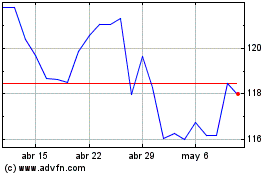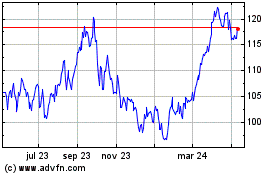By Bradley Olson
This article is being republished as part of our daily
reproduction of WSJ.com articles that also appeared in the U.S.
print edition of The Wall Street Journal (February 2, 2019).
HOUSTON -- The world's largest Western oil companies shrugged
off a 38% plunge in oil prices during the final months of 2018 to
post some of their biggest annual profits in years.
Strong fourth-quarter earnings Friday by Exxon Mobil Corp. and
Chevron Corp., following similar results by Royal Dutch Shell PLC
on Thursday, proved the extent to which the oil giants have
transformed amid lower crude prices.
The top five generated more profits last year, when crude prices
averaged just $71 a barrel, than in 2014, when global crude sold
for an average of almost $100 a barrel.
Including estimates for BP PLC and Total SA, which report next
week, they are set to post 2018 profits of about $84 billion,
according to FactSet data. That is about $10 billion more than four
years ago.
The companies are seeing benefits from a more disciplined
strategy focused on returns and profitability over growing
production, a demand from many investors who have been disappointed
by lackluster performance in recent years. Exxon and Chevron stock
prices rallied by more than 3%. Shell's U.S.-denominated shares
rose by more than 4% Thursday, the most in three months Chevron's
board authorized a $25 billion share repurchase program after the
company bought back $1 billion in stock in the fourth quarter, a
signal to investors that returns continue to be a top priority.
Collectively, the companies have restructured their businesses,
sold off assets and positioned themselves to thrive even when crude
prices swing up and down wildly.
Exxon, Chevron, BP and Shell are also turning to U.S. shale
drilling in the booming Permian Basin in West Texas and New Mexico,
where it is possible to increase production without a
multibillion-dollar project that could take at least a decade to
make money.
Despite the fall in prices at the end of the fourth quarter,
Exxon still generated $6 billion in net income in the period --
lower than the year before, which was boosted by the U.S. tax
overhaul, but still better than analysts had expected. Chevron said
net income was $3.73 billion, up 19% from the same time a year
ago.
"These companies have figured out how to operate in this new
environment, and they have adjusted well" to lower prices, said
Brian Youngberg, an analyst at Edward Jones in St. Louis.
"The key going forward will be maintaining discipline. This is
now a low-growth industry, so you've got to invest well," he
added.
Exxon and Chevron stock prices rallied by more than 3%. Shell's
U.S.-denominated shares rose by more than 4% Thursday, the most in
three months. Chevron's board authorized a $25 billion share
repurchase program after the company bought back $1 billion in
stock in the fourth quarter, a signal to investors that returns
continue to be a top priority.
Shell, Exxon and Chevron shares have rallied. Chevron's board
authorized a $25 billion share repurchase program, signaling to
investors that returns continue to be a priority.
On Thursday, Shell said it nearly doubled profits in 2018 from
the previous year, posting net income of about $23 billion.
Production at Exxon rose above 4 million barrels a day of oil
and gas for the first time since early 2017.
Exxon Chief Executive Darren Woods has embarked on a $230
billion plan to revitalize the oil giant, targeting drilling
opportunities around the world that he has said are the most
attractive he's seen in decades. Those include shale wells in West
Texas, natural gas export facilities in Papua New Guinea, a string
of giant discoveries in the South American nation of Guyana and
developments in Mozambique and Brazil.
While many analysts consider those projects to be extremely
attractive, they aren't set to pay off in a big way for a few more
years.
Exxon's shares fell about 15% in 2018, including dividends, the
worst performance for the company in at least 20 years, according
to FactSet data.
Mr. Woods said the company's ability to produce massive amounts
of oil and gas while also having the logistics and refining
capability to process barrels into fuel and other products was a
critical bulwark in 2018.
"The price environment in 2018 was unpredictable, which once
again demonstrated the value of our integrated business model," Mr.
Woods said. That vertical integration "allowed us to avoid the
impact of market dislocations and thus capture the full value of
our barrels," he added.
Mr. Woods also signaled that Exxon is set to step up asset sales
in its exploration and production business, which he plans to
reorganize into three new companies beginning in April.
The company recorded a $429 million impairment charge in the
quarter, much of which was from assets in North America "with
limited development potential." Total revenue and other income rose
8.1% to $72 billion.
Chevron Chief Executive Mike Wirth said the company has been in
discussions with U.S. officials related to its operations in
Venezuela and believes they will continue operating in a safe and
stable way for the foreseeable future. Chevron was among the
companies that received an exemption from U.S. sanctions imposed
this week against Venezuela's oil industry.
The exemption is set to expire in later this year, but it is
possible several companies may continue to receive waivers,
according to analysts.
Chevron plans to continue buying back significant quantities of
shares, and the company is set to purchase a Texas refinery. That
will allow the company to step up how much light crude it can
process as it ramps up production in the Permian Basin. Like Exxon,
Chevron nearly doubled its output in the region in 2018.
"We continue to maintain our commitment to capital discipline,"
Mr. Wirth said. "We intend to win in any environment."
Total revenues at Chevron rose 13% to $42 billion, and
production of oil and gas rose 7% to the equivalent of 2.93 million
barrels a day.
Excluding asset sales, the company said it expects production to
grow by 4% to 7% in 2019.
Allison Prang and Kimberly Chin contributed to this article.
Write to Bradley Olson at Bradley.Olson@wsj.com
(END) Dow Jones Newswires
February 02, 2019 02:47 ET (07:47 GMT)
Copyright (c) 2019 Dow Jones & Company, Inc.
Exxon Mobil (NYSE:XOM)
Gráfica de Acción Histórica
De Mar 2024 a Abr 2024

Exxon Mobil (NYSE:XOM)
Gráfica de Acción Histórica
De Abr 2023 a Abr 2024
